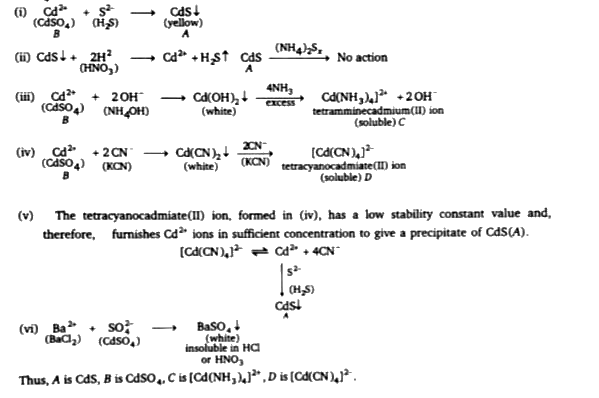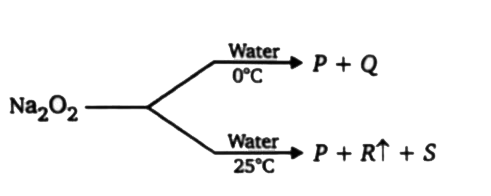(i) A yellow precipiate of the compound A is formed on passing H2S through a neutral solution of the salt B.
(ii) The compound A is soluble in hot dilute HNO3 but insoluble in yellow ammonium sulhpide.
(iii) The The solution of B, on treatment with a small quantitity of NH3, gives a white precipitate soluble in an excess of the reagent, forming a compound C.
(iv). The solution of B gives a white precipitate with a small concentration of KCN. the precipitate is soluble in an excess of the reagent, forming a compound D.
(v) the solution of D, on treatment with H2S, gives A.
(vi) The solution of B in dilute HCl, on treatment with a solution of BaCl2, gives a white precipitate of the compound E, which is almost insoluble in concentrated HNO3.
Q. Which of the following is the cation present in B?
As3+
Sb3+
Zn2+
Cd2+
The correct Answer is:D
The yellow precipitate of a sulphide could be CdS (group IIA) or As2S3/As2S3/SnS2 (group IIB), but as it is insoluble ini yellow ammonium polysulphide, it should be CdS. Thus, the cation appears to Be Cd2+ which is confirmed by reactions (ii) to (v). reaction (vi) indicates SO2−4,. hence, the compound B is CdSO4.

Topper's Solved these Questions
- QUALITATIVE INORGANIC ANALYSISBook:VK JAISWAL ENGLISHChapter:QUALITATIVE INORGANIC ANALYSISExercise:ONE OR MORE ANSWER IS/ARE CORRECT
Explore 43 Videos
- QUALITATIVE INORGANIC ANALYSISBook:VK JAISWAL ENGLISHChapter:QUALITATIVE INORGANIC ANALYSISExercise:MATCH THE COLUMN
Explore 4 Videos
- QUALITATIVE INORGANIC ANALYSISBook:VK JAISWAL ENGLISHChapter:QUALITATIVE INORGANIC ANALYSISExercise:LEVEL 2
Explore 76 Videos
- PERIODIC PROPERTIESBook:VK JAISWAL ENGLISHChapter:PERIODIC PROPERTIESExercise:MATCH THE COLUMN
Explore 11 Videos
- s-BLOCK ELEMENTSBook:VK JAISWAL ENGLISHChapter:s-BLOCK ELEMENTSExercise:SUBJECTIVE PROBLEMS
Explore 2 Videos
Similar Questions
Basic radical(s) which can not be identified by borax bead test:
View Solution
View SolutionWhen a reagent (X) reacts with Fe3+ salt solution turnsred due to the formation of a compound (Y). This reagent cause no change in colour with Fe2+ salt solution. Compound (X) and (Y) are respectively:
View Solution
View Solution
Calculate sum of bond order between same bonded atoms in Q and R compounds.
View SolutionThe metallic salt (XY) is soluble in water.
(a) When the aqueous soluble of (XY) is treated with NaOH solution, a white precipitate (A) is formed. In excess of NaOH solution, a white precipitate (A) is formed. In excess of NaOH solution, white precipitate (A) dissolves to form a compound (B). When this solution is boiled with soild NH4Cl, a precipitate of compound (C) is formed.
(b) An aqueous solution on treatment with BaCl2 solution gives a white precipitate (D) white is insoluble in conc HCl.
( c) The metallic salt (XY) forms a double salt (E) with potassium sulphate.
Identify (XY),(A),(B),(C),(D) and (E).
View SolutionA colourless (A) when place into water a heavy white turbidly of (B) solid (A) gives a close solution in conesolution in cone HCI when HCI solution is added to clear solution water ,(B) forms again (B) dissolves in dilute HCI . When H_(2)S is passed through a sespension of (A) or (B), a black precipitate (C ) forms , (C ) is insolves in yellow ammonium sulphide (NH_(4))_(2)S , cone H_(2)SO_(4) added to solid (A) liberates gas (D) gas (D) is water soluble and gives white precipitate with mercuric salts (E ) and not mercuric salt .The black precipitate (C ) dissolves in HNO_(3), (1,1) to give a solution to which H_(2)SO_(4) is added followed by addition of NH_(4)OH when a white precipitate (F) is formed (E ) gives a black ppt , (G) with solution of sodium stannite. Compound (C ) is also formed by the following reaction
View SolutionA colourless (A) when place into water a heavy white turbidly of (B) solid (A) gives a close solution in conesolution in cone HCI when HCI solution is added to clear solution water ,(B) forms again (B) dissolves in dilute HCI . When H_(2)S is passed through a sespension of (A) or (B), a black precipitate (C ) forms , (C ) is insolves in yellow ammonium sulphide (NH_(4))_(2)S , cone H_(2)SO_(4) added to solid (A) liberates gas (D) gas (D) is water soluble and gives white precipitate with mercuric salts (E ) and not mercuric salt .The black precipitate (C ) dissolves in HNO_(3), (1,1) to give a solution to which H_(2)SO_(4) is added followed by addition of NH_(4)OH when a white precipitate (F) is formed (E ) gives a black ppt , (G) with solution of sodium stannite. Compound (B ) is not soluble in
View SolutionWhich of the following statements is // are correct ? (I) White precipitate of Zn(OH)_(2) is soluble in excess ammonia and in solutions of ammonium salts. (II) Yellow precipitate of barium chromate is soluble in dilute acetic acid as well as in mineral acids. (III) Green precipitate of Ni(OH)_(2) is soluble in excess sodium hydroxide.
View Solution(i) A powdered substance (A) on treatment with fusion mixture gives a green coloured compound (B). (ii) The solution of (B) in boiling water on acidification with dilute H_(2)SO_(4) gives a pink coloured compound (C ) . (iii) The aqueous solution of (A) on treatment with NaOH and Br_(2)- water gives a compound (D). (iv) A solution of (D) in conc. HNO_(3) on treatment with lead peroxide at boiling temperature produced a compound (E) which was of the same coloure at that of (C). (v) A solution of (A) on treatment with a solution of barium chloride gave a white precipitate of compound (F) Which was insoluble in conc. HNO_(3) and conc. HCl. The oxidation state of central metal ions of (A), (B) and (C ) compounds are respectively :
View Solution(A) Give a blue solution in H_(2)O . On passing H_(2)S , a black precipitate (B) is formed which is soluble in HNO_(3) . On addition of NaOH, the solution gives glue precipitate (C ) which becomes black on boiling in NaOH. On passing ammonia into solution of (A) in water, a deep blue precipitate is ofrmed, which dissolves in excess of NH_(3) giving deep blue colouration (D). Treatment of KCN with aqueous solution of (A) gives a yellow ppt. (E) which dissloves in excess of KCN giving a colourless solution.
View SolutionAn aqueous solution of a substance, on treatment with dilute HCl, gives a white precipitate soluble in hot water. When H_(2)S is passed through the hot acidic solution, a black precipitate is formed. The substance is:
View Solution(i) A yellow precipiate of the compound A is formed on passing H_(2)S through a neutral solution of the salt B. (ii) The compound A is soluble in hot dilute HNO_(3) but insoluble in yellow ammonium sulhpide. (iii) The The solution of B, on treatment with a small quantitity of NH_(3) , gives a white precipitate soluble in an excess of the reagent, forming a compound C. (iv). The solution of B gives a white precipitate with a small concentration of KCN. the precipitate is soluble in an excess of the reagent, forming a compound D. (v) the solution of D, on treatment with H_(2)S , gives A. (vi) The solution of B in dilute HCl, on treatment with a solution of BaCl_(2) , gives a white precipitate of the compound E, which is almost insoluble in concentrated HNO_(3) . Q. Which of the following is the cation present in B?
View Solution(i) A yellow precipiate of the compound A is formed on passing H_(2)S through a neutral solution of the salt B. (ii) The compound A is soluble in hot dilute HNO_(3) but insoluble in yellow ammonium sulhpide. (iii) The The solution of B, on treatment with a small quantitity of NH_(3) , gives a white precipitate soluble in an excess of the reagent, forming a compound C. (iv). The solution of B gives a white precipitate with a small concentration of KCN. the precipitate is soluble in an excess of the reagent, forming a compound D. (v) the solution of D, on treatment with H_(2)S , gives A. (vi) The solution of B in dilute HCl, on treatment with a solution of BaCl_(2) , gives a white precipitate of the compound E, which is almost insoluble in concentrated HNO_(3) . Q. Which of the following anions is present in B?
View Solution(i) A yellow precipiate of the compound A is formed on passing H2S through a neutral solution of the salt B.
(ii) The compound A is soluble in hot dilute HNO3 but insoluble in yellow ammonium sulhpide.
(iii) The The solution of B, on treatment with a small quantitity of NH3, gives a white precipitate soluble in an excess of the reagent, forming a compound C.
(iv). The solution of B gives a white precipitate with a small concentration of KCN. the precipitate is soluble in an excess of the reagent, forming a compound D.
(v) the solution of D, on treatment with H2S, gives A.
(vi) The solution of B in dilute HCl, on treatment with a solution of BaCl2, gives a white precipitate of the compound E, which is almost insoluble in concentrated HNO3.
Q. Which of the following are the white precipitate and the soluble substance formed by the excess of the NaOH reagent, respectively?
View Solution(i) A yellow precipiate of the compound A is formed on passing H2S through a neutral solution of the salt B.
(ii) The compound A is soluble in hot dilute HNO3 but insoluble in yellow ammonium sulhpide.
(iii) The The solution of B, on treatment with a small quantitity of NH3, gives a white precipitate soluble in an excess of the reagent, forming a compound C.
(iv). The solution of B gives a white precipitate with a small concentration of KCN. the precipitate is soluble in an excess of the reagent, forming a compound D.
(v) the solution of D, on treatment with H2S, gives A.
(vi) The solution of B in dilute HCl, on treatment with a solution of BaCl2, gives a white precipitate of the compound E, which is almost insoluble in concentrated HNO3.
Q. Which of the following are the white precipitate and the soluble substance formed by the excess of the KCN reagent. respectively, in (iv) ?
View Solution

